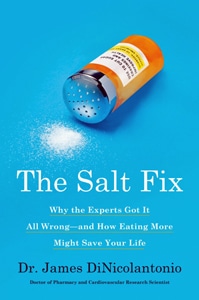
July 3, 2017
The Salt Fix: A Book Review
By Michael D. Shaw
The Salt Fix: Why the Experts Got It All Wrong—and How Eating More Might Save Your Life
By Dr. James DiNicolantonio
Crown Publishing Group, 201 pp., $26.99
Print ISBN: 978-0-451-49696-6
Ebook ISBN: 978-0-451-49697-3
This column has covered the low-salt mythology in August and February of 2014. Certainly, articles have appeared over the years on insider blogs attacking the low-salt orthodoxy. And, trade group The Salt Institute has been trying to set the record straight for a good long time.
But, James DiNicolantonio’s new book is among the first in the popular media that skewers the prevailing “wisdom” on this topic.
“We’ve all heard the recommendation: eat no more than a teaspoon of salt a day for a healthy heart. But there’s one big problem with this: the vast majority of us don’t need to eat low-salt diets. In fact, for most of us, more salt would be better for our health, rather than less. (Not to mention, much tastier.)”
Besides being a compelling read, this work is assiduously documented—replete with 670 references and notes. DiNicolantonio’s resume is sure to impress, and at first blush would seem unlikely for a contrarian….
James J. DiNicolantonio, PharmD is a research scientist and doctor of pharmacy at Saint Luke’s Mid America Heart Institute in Kansas City, MO. He has published more than two hundred papers in the medical literature, along with numerous articles on nutrition in the lay press. DiNicolantonio is the associate editor of BMJ Open Heart, and is also on the editorial advisory board of several other medical journals.
The book’s introduction sets the stage:
“You may have been mightily struggling to restrict yourself, not knowing that your salt cravings are totally, biologically normal, akin to our thirst for water.”
That stands to reason, in light of the 2300 milligram daily recommendation, compared to the scientific finding—across all populations—that when people are left to unrestricted sodium consumption, they tend to settle in at 3,000-4,000 mg per day.
Subsequent chapters lay out the physiological reasons and evolutionary basis for why salt intake is so essential. As to that 2300 mg figure, our kidneys are more than up to the task: They filter that amount of salt every five minutes! In fact, the stress on our kidneys mainly comes from having to conserve salt and reabsorb it. Thus, low-salt diets are an energy hog, and in some cases can lead us to become more sedentary. What’s more, low salt can raise the heart rate, and increase risk of heart attack.
What about the supposed hypertension connection? DiNicolantonio puts together the data, and notes that the prevalence of hypertension in the US in the first half of the 1900s was around 10 percent. Now, it is three times as high—despite salt intake remaining remarkably stable over the last 50 years.
Historical data on heart disease is even more interesting. Before the advent of refrigeration, salt was widely used for food preservation. Thus, in the 1500s, people were consuming 40,000 mg of salt per day, and if we are to believe the salt/hypertension/heart disease mantra, hundreds of thousands of such deaths should have been reported for this time. However, heart disease was not reported until the mid-1600s, jumping to serious levels in the early 1900s.
Indeed, DiNicolantonio details the sad history of the conventional wisdom on low salt. He is especially critical—as he should be—of the execrable work of Walter Kempner MD, and his Rice Diet (defended to this day by some woefully misguided “authorities”). While some blood pressure lowering results were observed, there were massive defects in methodology, including the fact that many of the subjects were obese and in hypertensive crisis (average 199/117 baseline from the get-go); and there was far more than just low salt in his Rice Diet, confounding reasonable analysis. Weight loss alone, promoted by the diet’s extreme calorie restriction, could have eased the hypertension.
The author delves into “paradoxes” whereby high-salt diet populations (South Korea, Japan, France) have very low rates of coronary heart disease. In short, The Salt Fix is a treasure trove for anyone who questions the conventional wisdom. And more people should, because with few exceptions, the incidence of most chronic conditions treated conventionally—such as hypertension, diabetes, obesity, and arthritis—keeps getting worse.
I’ll conclude with a few zingers from my interview with DiNicolantonio:
“There was no study ever proving that restricting salt is going to reduce cardiovascular events or mortality.”
“Consuming just four cups of coffee can cause you to lose up to a full teaspoon of salt; and yet, we’re told to consume less than a teaspoon of salt every day.”
“The American Heart Association [low-salters] tells everyone to exercise every day, and we lose a ton of salt in our sweat. It’s just so counterintuitive, it doesn’t make any sense. We can lose a teaspoon of salt every single hour when working out in the heat.”
